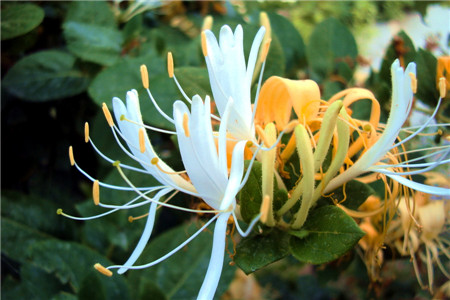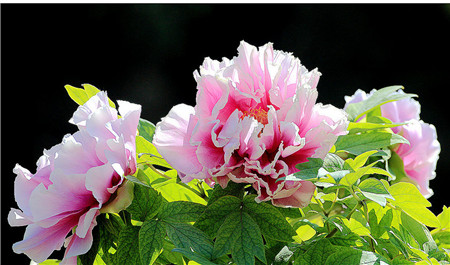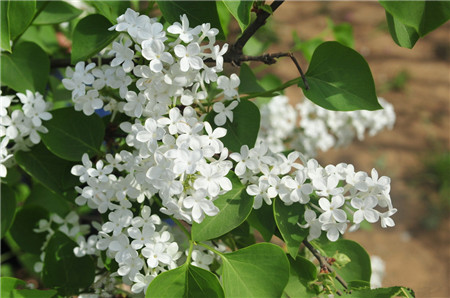Cultivation techniques of Flos Lonicerae
Honeysuckle has strong adaptability, and the choice of soil and climate is not strict, and the sandy loam with thicker soil layer is the best. Hillsides, terraces, Weirs, dams and barren hills can all be cultivated. Propagation can be done by sowing, cuttings and root splitting. Bud and blossom on the new branch of the year. Soil requirements are not strict, acidic, saline-alkali soil can grow. With developed roots and strong roots, it is a good soil-fixing and water-conserving plant, which can be planted on hillsides and river embankments, so the agricultural proverb says: "waterlogged crops, dry grass, frozen pomegranates and sunburned melons will not affect honeysuckle."
Seed Propagation of cultivation techniques of Honeysuckle
Sow the seeds in April, soak the seeds in warm water of 35-40 degrees Celsius for 24 hours, remove 2-3 times wet sand to promote germination, and sow seeds when the split □ reaches about 30%. Sow seeds in trenches on the border according to the row spacing of 21: 22 cm, cover the soil with 1 cm, spray water once every 2 days, emerge in more than 10 days, transplant after autumn or in the spring of the second year, use about 15 kg of seeds every 1 hour.
Cutting Propagation of cultivation techniques of Flos Lonicerae
Take place in the rainy season. In the overcast and rainy weather in summer and autumn, the sturdy, disease-free, 2-year-old branches are cut into 30cm and 35cm, and the lower leaves are cut off as cuttings. On the selected land, the hole is dug according to the row spacing of 1.6m and the plant spacing of 1.5m. The depth of the hole is 160cm, each hole has 5cm cuttings, scattered oblique standing in the soil, the ground is exposed about 7cm, and the fill is compacted (the sandy soil with good air permeability is the best). [11]
The cutting branches should pay attention to shade before taking root, so as to avoid the branches drying up caused by direct sunlight. Cuttings can also be used to raise seedlings; from July to August, according to the row spacing of 23 cm 26 cm, trench, depth of 16 cm, plant spacing of 2 cm, put the cuttings obliquely into the ditch, fill compaction, take the sandy soil with good permeability as seedling soil, root the fastest, and is not easy to be attacked by bacteria and cause branch rot. After planting, it was sprayed with water, and then when it was dry, it should be watered every 2 days, it could take root in about half a month, and transplant in spring or autumn of the first year.

Shaping and pruning of cultivation techniques of Flos Lonicerae
Pruning is carried out after falling leaves in autumn to before sprouting in spring, such as light pruning of strong branches, strong pruning of weak branches, and pruning of all branches. when pruning, we should pay attention to ventilation and light transmission after the new branches grow. The thin and weak branches, withered old branches and basal branches are all cut off, and the pruning of the plots with poor fertilizer and water conditions is heavier, and the old branches are cut off with the aging of the plant to promote the development of new branches. The young plants are mainly cultured plant type, which should be cut lightly, 4-5 trunk branches should be left in the mountain plot, 1-2 trunk branches should be left in the plain land, and the trunk should be cut off slightly to make it thicker and upright. Cultivation methods of Flos Lonicerae
Honeysuckle, also known as mandarin duck vine, double flower, etc., because honeysuckle blossoms for snow white, and then golden yellow, and at the same time two distinct colors on the branches, so named. The vines of honeysuckle can be wound around other objects, so you need to pay attention to creating a support for winding honeysuckle to grow.
Honeysuckle
As a result of the careful cultivation of the working people in cultivation, honeysuckle has cultivated some cultivated varieties. the common ones are: red honeysuckle, red with purple, poor cold tolerance, cultivation in North China should be in the courtyard shelter from the wind and the sun; purple honeysuckle, leaf vein purple, Corolla white and purple halo or purple edge. Honeysuckle in the four seasons blossoms all year round except that it cannot blossom at a low temperature in winter. Red honeysuckle and purple vein honeysuckle have poor cold tolerance and can be potted in North China and moved indoors in winter. Families living in buildings can also plant plants on the balcony and tie them into branches with small bamboo poles or lead wires.
The frame leads to its climbing and winding, and the variety is suitable for the four seasons honeysuckle, so that it can enjoy its fragrant flowers throughout the growing period. Cut off the climbing branches and move them into the indoor collection after winter, or pour enough water before freezing and let them freeze through the winter.
Honeysuckle can climb flower racks, hedges, walls. The fragrance of the flowers is pleasant, especially the honeysuckle of the four seasons, from spring to autumn, the flowers are constantly interlaced with gold and silver. if planted in the courtyard, you can enjoy the flowers and smell the fragrance; in the hot summer, it is even more enjoyable to enjoy the cool and shade under the honeysuckle rack.
Honeysuckle has no special requirements for soil, general soil can grow, but should not be planted in too shady, too dry and too wet, stagnant water. In the second year after planting, you should set up flower racks or move close to hedges and walls in order to find things to cling to, winding and climbing.
Three or four years later, it is appropriate to carry out a shearing to cut off the cluttered and crossed branches, otherwise it is too crowded and easy to cause aphids, insects and other pests; at the same time, it can promote ventilation, light transmission, and conducive to flowering. It is also necessary to water the flowers in a timely manner during the drought season so as not to make the flowers fall due to drought. Amoy rice water, wash fish, meat dirty water, fully fermented can be irrigated. If aphids and shell insects are found to be harmful, they should be sprayed with 1500 times dimethoate or soaked in tobacco leaves. Soot disease is also easy to occur in high temperature and drought, which can be controlled by topiramate or carbendazim.
Friends living in the building, can also build a flower pool on the balcony, about 0.5 meters wide square, add 40 cm thick fertile soil can be planted, pull a few wires, ropes or tie up a few small bamboo poles on the balcony, let it climb; summer can not only shade, but also enjoy the flowers and smell incense, in its shade, you can plant and put other flowers. In winter, the flower pond can be overwintered by properly covering two layers of grass curtains or covered with a layer of plastic film, sprouting and spreading leaves early in spring, withered and yellow leaves late in winter, which adds a lot of color to the balcony.
The flowers, leaves and branches of honeysuckle can be used as medicine. It has the effects of promoting fluid, relieving thirst, dampening fever, dispelling wind and relieving appearance. It is one of the main drugs of Yinqiao jiedu pills. It is also indispensable for the treatment of colds and the prevention and treatment of measles in children. Hot summer, picking flowers and tea brewing or single flower instead of tea, after drinking has the effect of dispelling summer heat and eyesight. Picking off the unopened buds of honeysuckle to dry is the double flower of traditional Chinese medicine; the pruned branches are cut into small segments, which is the honeysuckle vine of traditional Chinese medicine.
Planting techniques of Flos Lonicerae
Therefore, the farmer proverb says: "waterlogged crops dry dead grass, frozen to death pomegranate sunburn melon, will not affect honeysuckle." Honeysuckle has strong adaptability, and the choice of soil and climate is not strict, and the sandy loam with thicker soil layer is the best. Hillsides, terraces, Weirs, dams and barren hills can all be cultivated. Propagation can be done by sowing, cuttings and root splitting.
Sow the seeds in April, soak the seeds in 35-40 ℃ warm water for 24 hours, remove 2-3 times wet sand to promote germination, and sow seeds when the crack reaches about 30%. Sow seeds in trenches on the border according to row spacing 21~22cm, cover soil with 1cm, spray water once every 2 days, seedling can emerge in more than 10 days, transplant after autumn or spring of the second year, and seed 15kg is used every 1 hour.
Cutting propagation of honeysuckle is usually carried out in the rainy season. In the overcast and rainy weather in summer and autumn, the sturdy 1-2-year-old branches without diseases and insect pests were cut into 30~35cm, and the lower leaves were cut off as cuttings. On the selected land, the hole was dug according to the row spacing of 1.6m and the plant spacing of 1.5m. The hole was deep 16~18cm, each hole had 5-6 cuttings, scattered oblique standing buried in the soil, 7~10cm exposed on the ground, left and right, and the soil was compacted. The cutting branches should pay attention to shade before taking root, so as to avoid the branches drying up caused by direct sunlight. Cutting can also be used to raise seedlings.
From July to August, according to the row spacing 23~26cm, the cuttings were placed obliquely in the ditch, filled and compacted, and the sandy soil with good permeability and permeability was used as the seedling soil, which took root the fastest and was not easy to be attacked by bacteria and caused branch rot. Spray water after planting, and then water it every 2 days when it is drought. it can take root in about half a month, and transplant in spring or autumn of the second year.
When the flowers bloom, they are first white, then yellow, white like silver, yellow like gold, gold and silver, gorgeous and colorful, so they are called honeysuckle. Also because one pedicel two flowers, two stamens protruding out, in pairs, inseparable, like male and female companions, but also like mandarin duck pair dance, so it is known as mandarin duck vine. If you want to pay more attention to woody flowers, please continue to pay attention to succulent flower beds.
- Prev

How to plant peonies?
Although the peony is good-looking, it is not easy to grow. How to plant the peony? Today, Flower Encyclopedia will answer for you how to plant peonies. 1. Choose sunny, non-stagnant land, preferably a sunrise slope, sandy loam with fertile soil and good drainage. Turn the soil deeply before planting, and the planting pit should be appropriately large.
- Next

Cultivation and management methods of lilac
First of all, the cultivation and management methods of cloves should be clearly distinguished between medicinal cloves and ornamental cloves, which are two completely different plants. The cultivation and management methods of medicinal cloves and ornamental cloves are different.
Related
- Fuxing push coffee new agricultural production and marketing class: lack of small-scale processing plants
- Jujube rice field leisure farm deep ploughing Yilan for five years to create a space for organic food and play
- Nongyu Farm-A trial of organic papaya for brave women with advanced technology
- Four points for attention in the prevention and control of diseases and insect pests of edible fungi
- How to add nutrient solution to Edible Fungi
- Is there any good way to control edible fungus mites?
- Open Inoculation Technology of Edible Fungi
- Is there any clever way to use fertilizer for edible fungus in winter?
- What agents are used to kill the pathogens of edible fungi in the mushroom shed?
- Rapid drying of Edible Fungi

